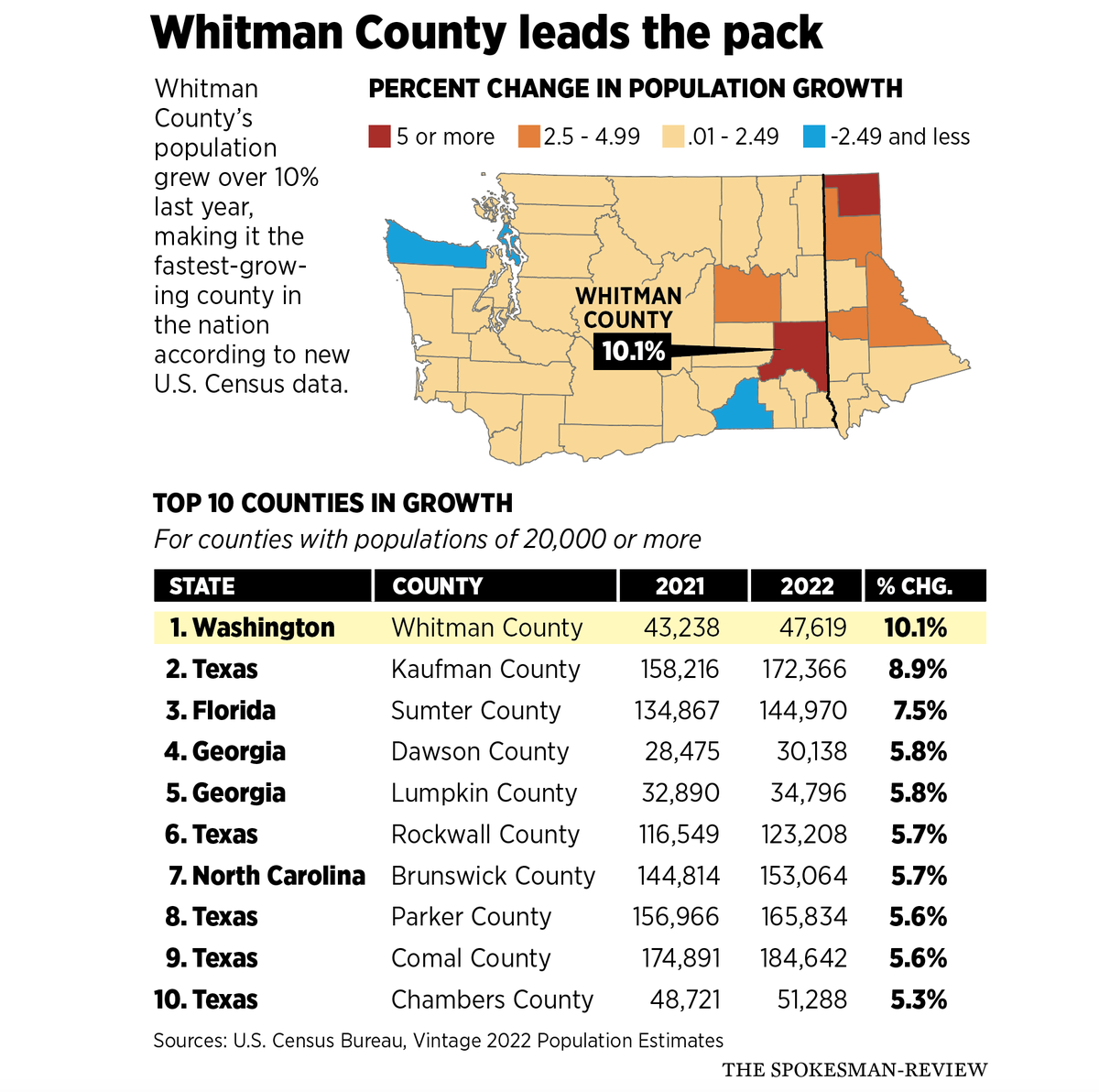Whitman County was fastest growing in the nation last year, census data shows

Whitman County’s population grew 10.1% last year, making it the fastest-growing county in the nation.
From July 2021 to July 2022, the county grew from 43,238 residents to 47,619 residents, according to the Census Bureau’s Vintage 2022 estimates.
The dramatic increase is a rebound from a nearly equivalent decrease the year before, when the county’s population dropped 9.6%.
This appears to be an effect of the pandemic.
“Whitman County’s change is just one example of the many college counties that saw a rebound in the last year after a lull during the COVID-19 pandemic,” a Census news release said.
The county south of Spokane is mostly rural except for the impact of Washington State University in Pullman.
The census estimates are based on records from births, deaths and tax returns. It also includes such residency information as college dormitory occupancy.
Phil Weiler, vice president of communications at WSU, said the numbers are skewed because of the university’s large student body.
“Pullman is a unique community,” Weiler said. Every summer the population drops when many students leave town.
Still, the data reflects the different pandemic approaches of WSU and its neighbor 8 miles across the border, the University of Idaho in Moscow.
Latah County and Whitman County are demographically similar – both are small counties with large college towns. But Latah County had no corresponding dip in population during the pandemic. It grew steadily from 39,629 residents to 40,978 residents over the same two-year period.
During the 2020-21 school year, WSU shifted most classes online while U of I kept most classes in-person.
“We told students to go home during spring break and don’t come back,” Weiler said. “We saw a mass exodus from campus.”
WSU’s enrollment declined during the pandemic and hasn’t rebounded. Enrollment at the Pullman campus slid from 20,976 students in fall 2019 to 17,827 students last fall.
Universities across the country lost over a million students during the pandemic.
“That’s a challenge at a university level but also a concern at a societal level,” Weiler said.
WSU is making outreach efforts to bring some of those students back. A hopeful sign is that Pullman ’s freshmen class grew last fall for the first time in four years.
Despite the dramatic increase last year, Whitman County’s overall population still hasn’t quite recovered from its April 2020 peak of 47,973.
Whitman County Commissioner Art Swannack said the biggest impact was on small businesses, which lost their student patrons on top of COVID-19 restrictions.
Otherwise, besides a slight decrease in workload for some departments, the drop and rebound didn’t cause any major problems for the county’s operations.
“Compared to 2019, we’re back to where we were then in terms of workload,” Swannack said.
Pullman City Administrator Mike Urban thinks the drop was less dramatic than the estimate shows. A lot of activity continued in town even though people were social distancing, he said.
There was a lull in local sales tax revenue but it was not as bad as one would expect by reading the census numbers.
“We are pleased the students have returned to campus,” Urban said. “They are a fun and vital part of the community.”
Other notable numbers and trends
In Idaho, Boundary County also had a relatively high growth rate. It grew 5.6% from 12,635 residents to 13,345 residents, making it the fastest-growing county in Idaho.
But Jaap Vos, a rural demographer at the University of Idaho, cautioned that percentage is not necessarily a meaningful measure of growth. He said it is important to look at underlying trends.
“Boundary County might be growing really fast percentage-wise,” he said, “but what are the actual numbers?”
A difference of 700 people is not that much, Vos said.
Overall, Idaho was steadily growing over the last decade until sometime last year, when it flattened out. Vos believes this is because of the sudden increases in mortgage rates, making it more difficult for people to move.
The census data didn’t fully capture this effect, since the Federal Reserve began increasing interest rates in March 2022 and the census dataset only went to July. That’s another reason to be careful with over-interpreting the data.
“Estimates often are very good,” Vos said. “But if you have a major event happening, like interest rates going up, then it’s more likely that estimate is not quite right. I think in rural places especially, estimates can be pretty wrong.”
By examining driver’s license data, Vos recently found that one in four people in Idaho’s growing 1.8 million population moved to the state in the past 10 years. He discovered that the influx of new residents coincided with a departure of existing residents.
After some of the nation’s most populous counties experienced significant outmigration and population declines in 2021, overall patterns of population growth and decline are moving towards pre-pandemic rates, the Census Bureau said.
Behind Whitman County, half of the top 10 fastest-growing counties over 20,000 people were in Texas.
The remaining fastest-growing counties were in Florida, Georgia and North Carolina.
Maricopa County in Arizona had the most overall growth, adding 56,831.
Spokane County grew a modest 0.77% from 545,498 people to 549,690 people.
Most counties in Washington grew at least a little. Only Clallam, Island and Walla Walla counties saw declines.